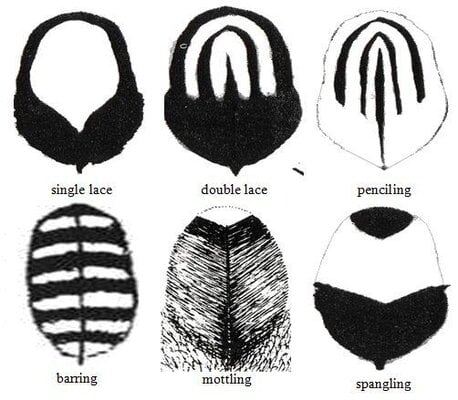The Kooky Kiwi
Crowing
Here's an excerpt/adaptation from another BYC article that I have always found very visually handy. The full post (which I recommend reading) can be found here:
https://www.backyardchickens.com/articles/genetics-an-attempt-at-simplifying-the-complex.64782/
It illustrates the different combinations of genes required to get the various patterns.
The required combinations can vary ever so slightly depending on what the starting base of the bird is.
For example sebrights are a Birchen based (Er) bird and require Dark Brown to form a single lace.
Birds with a Brown Base (Eb) do not require Dark Brown to form a single lace.
NB: Each of these genes has it's own pattern of inheritence. Some are recessive, some are sex linked, etc. So you need to familiarise yourself with each one to determine how they will pass from your parent birds to your chicks.

Co = Columbian
Pg = Pattern Gene (some call it pencilling)
Ml = Melanotic
Db = Dark Brown
· Co + Pg + Ml = Single Lacing
· Co + Pg + Ml + Db = Single Lacing (In Sebrights)

· Co + Ml = Quail Type Pattern - Columbian with patterned back

· Pg + Ml = Double Laced

· Db + Pg + Ml = Spangled

As previously mentioned by other posters - You can also build a spangled feather using Mottle as a base.
It would be fair to say that you need to use a combination of genes that first give you the colours you need, then move the black around the feather the correct way to form the spangle.
If you are missing one gene in the combination then you'll get example like "partial spangles" or "partial lacing", and all manner of other unusual effects in between
https://www.backyardchickens.com/articles/genetics-an-attempt-at-simplifying-the-complex.64782/
It illustrates the different combinations of genes required to get the various patterns.
The required combinations can vary ever so slightly depending on what the starting base of the bird is.
For example sebrights are a Birchen based (Er) bird and require Dark Brown to form a single lace.
Birds with a Brown Base (Eb) do not require Dark Brown to form a single lace.
NB: Each of these genes has it's own pattern of inheritence. Some are recessive, some are sex linked, etc. So you need to familiarise yourself with each one to determine how they will pass from your parent birds to your chicks.

Co = Columbian
Pg = Pattern Gene (some call it pencilling)
Ml = Melanotic
Db = Dark Brown
· Co + Pg + Ml = Single Lacing
· Co + Pg + Ml + Db = Single Lacing (In Sebrights)

· Co + Ml = Quail Type Pattern - Columbian with patterned back

· Pg + Ml = Double Laced

· Db + Pg + Ml = Spangled

As previously mentioned by other posters - You can also build a spangled feather using Mottle as a base.
It would be fair to say that you need to use a combination of genes that first give you the colours you need, then move the black around the feather the correct way to form the spangle.
If you are missing one gene in the combination then you'll get example like "partial spangles" or "partial lacing", and all manner of other unusual effects in between

Last edited:





